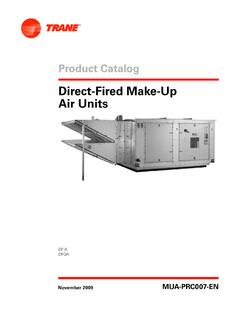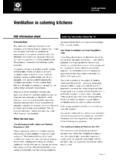Transcription of 9.10.2.2 Peanut Processing - United States Environmental ...
1 Peanut GeneralPeanuts (Arachis hypogaea), also known as groundnuts or goobers, are an annual leguminousherb native to South America. The Peanut peduncle, or peg (the stalk that holds the flower), elongatesafter flower fertilization and bends down into the ground, where the Peanut seed matures. Peanutshave a growing period of approximately 5 months. Seeding typically occurs mid-April to mid-May,and harvesting during August in the United , sandy loam soils are preferred for Peanut production. Moderate rainfall of between51 and 102 centimeters (cm) (20 and 40 inches [in.]) annually is also necessary.
2 The leading peanutproducing States are Georgia, Alabama, North Carolina, Texas, Virginia, Florida, and Process DescriptionThe initial step in Processing is harvesting, which typically begins with the mowing of maturepeanut plants. Then the Peanut plants are inverted by specialized machines, Peanut inverters, that dig,shake, and place the Peanut plants, with the Peanut pods on top, into windrows for field curing. Afteropen-air drying, mature peanuts are picked up from the windrow with combines that separate thepeanut pods from the plant using various thrashing operations. The Peanut plants are deposited backonto the fields and the pods are accumulated in hoppers.
3 Some combines dig and separate the vinesand stems from the Peanut pods in 1 step, and peanuts harvested by this method are cured in small producers still use traditional harvesting methods, plowing the plants from the ground andmanually stacking them for field is normally followed by mechanical drying. Moisture in peanuts is usually keptbelow 12 percent, to prevent aflatoxin molds from growing. This low moisture content is difficult toachieve under field conditions without overdrying vines and stems, which reduces combine efficiency(less foreign material is separated from the pods). On-farm dryers usually consist of either storagetrailers with air channels along the floor or storage bins with air vents.
4 Fans blow heated air(approximately 35 C [95 F]) through the air channels and up through the peanuts. Peanuts are driedto moistures of roughly 7 to 10 Peanut mills take peanuts from the farm to be further cured (if necessary), cleaned,stored, and processed for various uses (oil production, roasting, Peanut butter production, etc.). Majorprocess steps include Processing peanuts for in-shell consumption and shelling peanuts for other In-shell Processing -Some peanuts are processed for in-shell roasting. Figure presents a typical flowdiagram for in-shell Peanut Processing . Processing begins with separating foreign material (primarilysoil, vines, stems, and leaves) from the Peanut pods using a series of screens and blowers.
5 The podsare then washed in wet, coarse sand that removes stains and discoloration. The sand is then screenedfrom the peanuts for reuse. The nuts are then dried and powdered with talc or kaolin to whiten theshells. Excess talc/kaolin is shaken from the Peanut And Agricultural , AND OTHER TRASHLEAVES, STEMS, VINES,SANDWASHINGSCREENINGDRYINGPOWDERIN GTALC OR= PM EMISSIONSSANDKAOLININ-SHELL FACTORS1/95 Figure Typical in-shell Peanut Processing flow Shelling -A typical shelled Peanut Processing flow diagram is shown in Figure Shellingbegins with separating the foreign material with a series of screens, blowers, and magnets.
6 Thecleaned peanuts are then sized with screens (size graders). Sizing is required so that Peanut pods canbe crushed without also crushing the Peanut , shells of the sized peanuts are crushed, typically by passing the peanuts between rollersthat have been adjusted for Peanut size. The gap between rollers must be narrow enough to crack thepeanut hulls, but wide enough to prevent damage to the kernels. A horizontal drum, with a perforatedand ridged bottom and a rotating beater, is also used to hull peanuts. The rotating beater crushes thepeanuts against the bottom ridges, pushing both the shells and peanuts through the perforations.
7 Thebeater can be adjusted for different sizes of peanuts, to avoid damaging the Peanut kernels. Shells areaspirated from the Peanut kernels as they fall from the drum. The crushed shells and Peanut kernelsare then separated with oscillating shaker screens and air separators. The separation process alsoremoves undersized kernels and split crushing and hull/kernel separation, Peanut kernels are sized and graded. Sizing andgrading can be done by hand, but most mills use screens to size kernels and electric eye sorters forgrading. Electric eye sorters can detect discoloration and can separate peanuts by color grades.
8 Thesized and graded peanuts are bagged in (100-lb) bags for shipment to end users, such aspeanut butter plants and nut roasters. Some peanuts are shipped in bulk in rail hopper Roasting -Roasting imparts the typical flavor many people associate with peanuts. During roasting,amino acids and carbohydrates react to produce tetrahydrofuran derivatives. Roasting also dries thepeanuts further and causes them to turn brown as Peanut oil stains the Peanut cell walls. Followingroasting, peanuts are prepared for packaging or for further Processing into candies or Peanut Peanut roasting processes are shown in Figure There are 2 primary methods forroasting peanuts, dry roasting and oil Roasting -Dry roasting is either a batch or continuous process.
9 Batch roasters offer the advantage ofadjusting for different moisture contents of Peanut lots from storage. Batch roasters are typicallynatural gas- fired revolving ovens (drum-shaped). The rotation of the oven continuously stirs thepeanuts to produce an even roast. Oven temperatures are approximately 430 C (800 F), and peanuttemperature is raised to approximately 160 C (320 F) for 40 to 60 min. Actual roasting temperaturesand times vary with the condition of the Peanut batch and the desired end dry roasters vary considerably in type. Continuous roasting reduces labor, ensuresa steady flow of peanuts for other processes (packaging, candy production, Peanut butterproduction, etc.)
10 , and decreases spillage. Continuous roasters may move peanuts through an oven on aconveyor or by gravity feed. In one type of roaster, peanuts are fed by a conveyor into a stream ofcountercurrent hot air that roasts the peanuts. In this system, the peanuts are agitated to ensure that airpasses around the individual kernels to promote an even roasted peanuts are cooled and blanched. Cooling occurs in cooling boxes or onconveyors where large quantities of air are blown over the peanuts immediately following is necessary to stop the roasting process and maintain a uniform quality. Blanching removesthe skin of the Peanut as well as dust, molds, and other foreign material.














